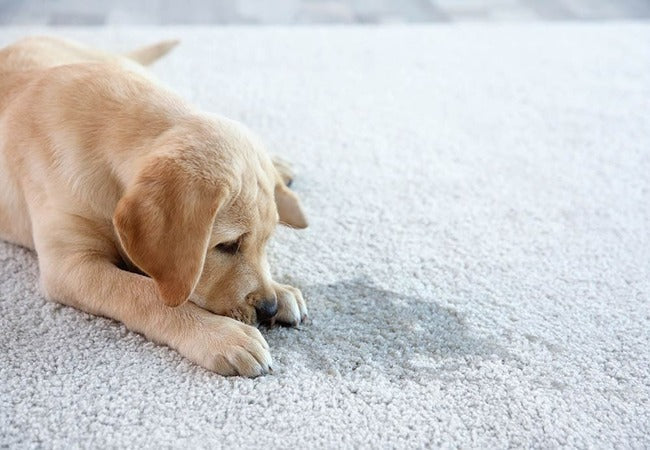Urine Marking in Dogs in 2025 – Vet‑Approved Guide to Understanding & Stopping Marking 🐶🚽

In this article
Urine Marking in Dogs in 2025 – Vet‑Approved Guide to Understanding & Stopping Marking 🐶🚽
By Dr. Duncan Houston BVSc
Urine marking is a natural behavior where dogs leave small amounts of urine on vertical surfaces to communicate messages through scent. While common—especially in young intact males—indoor marking can become a nuisance and sometimes signal deeper issues. In this in‑depth 2025 guide, I’ll explain the reasons behind marking, how to tell it apart from simple indoor peeing, and the most effective ways to manage, train, and support your dog with kindness and veterinary guidance.
1. What Is Urine Marking? 🤔
Urine marking differs from regular peeing. Instead of emptying the bladder, the dog deposits small amounts—often on walls, furniture legs, carpets, or doors—to leave scent messages for others. This helps establish territory, signal reproductive status, or respond to environmental changes.
2. Common Causes of Marking
- Territorial signaling: Dogs claim space by marking entrances, windows, or items with other animals’ scents.
- Sexual behaviors: Intact males and females in heat mark more as part of mating communication.
- Anxiety or stress: Change in the household—new baby, visitors, or furniture—can trigger marking.
- Conflict or social dynamics: Multi-dog households may mark due to resource competition or hierarchy changes.
- Medical issues: Some diseases (UTIs, incontinence, cognitive decline) may cause frequent urination mistaken for marking.
3. Who Marks & When?
- Young intact males—most likely; marking often begins around sexual maturity (6–12 mo).
- Spayed/neutered dogs—while hormonal triggers lessen, learned habits or tension can still lead to marking.
- Adult and senior dogs—stress, anxiety, medical changes, or cognitive disorders can lead to marking episodes.
4. How to Tell Markings from Accidents
| Behavior | Marking | House‑soiling |
|---|---|---|
| Urine amount | Small dribble | Full stream/puddle |
| Location | Vertical objects, repeat places | Random or near accessible exits |
| Context | Often after an outdoor walk or new stimuli | Usually due to lapse or incontinence |
5. Start with Veterinary Evaluation
Any sudden onset or change in marking should be evaluated with your vet. They may recommend:
- Urinalysis to detect infection, crystals, or disease.
- Full health screening (kidney, endocrine, neurological) if underlying issues are suspected.
6. Environment Management
- Clean with enzyme-based cleaners: prevents dogs from re-marking the same spot.
- Block access: close off rooms or use baby gates near frequent marking areas.
- Belly bands: male wraps can contain indoor marking—use short-term only and change often.
- Remove external stimuli: reduce marking triggers like other animals' scents by blocking windows or limiting exposure.
7. Behavior Modification Strategies
Desensitization & Counter-Conditioning
- Start at distance from triggers—reward calm behavior.
- Gradually increase exposure while continuing to reinforce neutral or positive responses.
Teaching Alternative Behaviors
- “Leave it” and “place” commands redirect focus away from marking spots.
- Encourage calm mat time or rewarding time-outs in softer areas when triggers are present.
8. Routine & Reassurance
- Maintain structured routines—consistent feeding, play, walks to build security.
- Reduce stress—consider pheromone diffusers if marking is anxiety-driven.
- Introduce environmental enrichment and calm background sounds during peak stress times.
9. Spay/Neuter When Appropriate
Alteration often significantly reduces marking in intact dogs—though behavioral patterns may persist if established early.
10. When to Seek Professional Help
- Marking persists after veterinary and environmental interventions.
- It is part of wider behavioral issues (anxiety, aggression, multi-dog conflict).
- Working with a certified veterinary behaviorist or professional trainer is advised.
11. Quick Reference Table
| Situation | Action | Goal |
|---|---|---|
| Sudden marking | Vet exam + urinalysis | Rule out medical causes |
| Re-marked spot | Clean thoroughly, block access | Break habit loop |
| Outdoor-triggered marking | Training + distraction at threshold | Shift emotional response |
| Hormonal marking | Spay/neuter + habit retraining | Reduce instinctual drive |
12. 📱 Ask A Vet App 2025 Support
Using the Ask A Vet app, you can:
- 📹 Upload videos of your dog's marking to get expert analysis.
- 🗂 Receive custom desensitization & counter-conditioning plans.
- 💬 Speak with vets/behaviorists for guidance when self-help isn't enough.
Expert support helps you reset your dog’s boundaries and build secure, peaceful habits. 🐾📲
❤️ Final Thoughts
Urine marking is an instinctive dog behavior—often healthy, but occasionally frustrating inside the home. With veterinary input, environment management, positive training, and expert support, you can reduce marking and support your pet’s sense of security and well-being. In 2025, we embrace compassionate, science-backed strategies to help dogs feel calm and confident—no matter the triggers. 🐶🚽
Need tailored advice? Visit AskAVet.com or download the Ask A Vet app today to start your journey toward a marking-free home.






